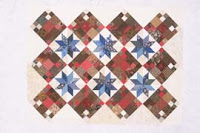
As I work on my next piece it occurred to me that I think a lot about the quilting design. Here are some thoughts on how to choose a design.
An un-quiltied top
Questions
1. Do I intend to hand or machine quilt? Knowing the method in advance will help you select a design that is most easily accomplished with that method.
2. How much time do I have for this project? Some designs are faster to stitch than others. If you know time is limited, design choices will be limited, too.
3. What is my skill level? If you are proficient at machine quilting, your design choices are much greater than if you are just learning. A novice machine quilter might choose designs which involve the walking foot (or even-feed feature) that require only minimal use of free-motion.
4. What use will this quilt serve? Heirloom quilts, of course, deserve much more intricate quilting designs than a functional. Wall quilts that will never be washed can have a much more open design, with widely spaced lines.
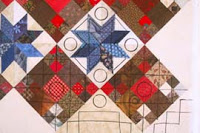
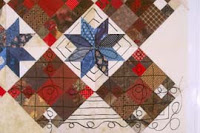
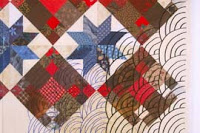
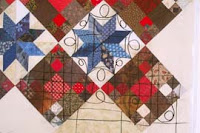
Four different design possibilities - A piece of Duralar purchased at the art supply store, be sure to apply tape to the edges so you can see the edges. And a Vis-a-Vis water based pen for drawing potential designs. The pen is easy to erase to try another design.
Goals
1. The amount of quilting should be adequate to hold the three layers together. The function of the quilt is important: a quilt that will be handled a lot needs more quilting than one that will simply hang on the wall.
2. The quilting should be uniform across the quilt surface. Quilting looks best when the quilting lines are evenly distributed across the surface.
3. The quilting design should complement the quilt top. Often, it is difficult to visualize whether or not a design will “look good” stitched through the layers. Experience observing the quilting on other quilts will help; pay careful attention to the ways quilters have finished their pieces next time you go to your guild’s show.
Basic Categories of Designs
All quilting designs consist of either lines, shapes, or a combination of both. The key when designing is to consider as many variations as possible before settling upon the design to stitch.
Play around with straight lines; then try curved lines. Vary the length of the lines; see what you can do with short lines then with long lines. Change the direction of the lines from up-and-down to horizontal then to diagonal. Keeping in mind the maximum spacing allowed for your quilt batt and the quilt’s function, try widely spaced lines then audition them at many other dimensions.
When working with shapes, size is important. The size of the shape should look right in relation to the size of the patch or patches over which it is stitched. Play around with placement of the shape. For a traditional treatment, place a shape in the center. For an innovative look, try placing the shape off-center. As with lines, shapes can be angular or curved. Audition shapes of both characters before selecting the one that looks right to you.
Conclusion
The ideal approach to quilting design is to think “what if.” What if I tried a curved design instead of a straight one? What if I tried an informal design of allover wiggly lines instead of placing shapes in specific places? What if I made this shape bigger or smaller? What if I used this shape, or that shape, or another one? What if I paired the shape with a grid, a meander, or another shape?
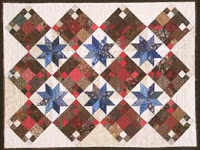 American Pie 'quilted'
American Pie 'quilted'
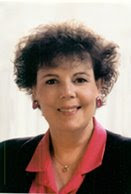








No comments:
Post a Comment